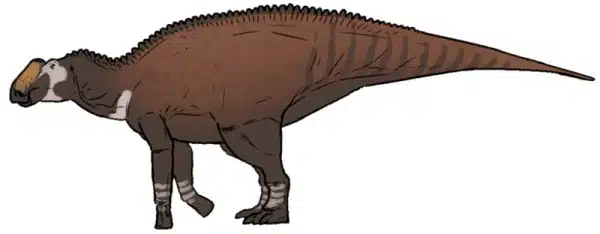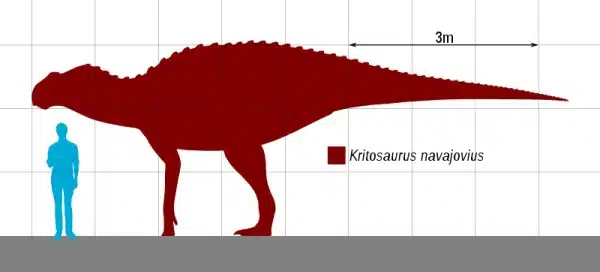Delving into the world of dinosaurs is like opening a time capsule that takes us back millions of years. Today, let’s explore the fascinating Kritosaurus, a dinosaur that roamed the earth during the Late Cretaceous Period. Its name is derived from Greek, meaning ‘Separated Lizard’. This is a nod to its unique skeletal features that set it apart from its contemporaries.
Kritosaurus, a member of the Hadrosaurid family, presents a captivating study into the diverse world of the Cretaceous Period. This herbivorous creature was first discovered in 1904 and has since intrigued paleontologists and enthusiasts alike. Its discoveries in New Mexico and later in regions like Alberta and Texas paint a picture of a dinosaur that thrived in various North American habitats.
Kritosaurus Key Facts
| Keyword | Fact |
|---|---|
| Pronunciation | KRIT-oh-SORE-us |
| Meaning of name | Separated Lizard |
| Group | Ornithopod |
| Type Species | Kritosaurus navajovius |
| Diet | Herbivore |
| When it Lived | 85.8 to 70.6 MYA |
| Period | Late Cretaceous |
| Epoch | Late/Upper Santonian to the top of the Late/Upper Campanian |
| Length | 30.0 feet |
| Height | Approximately 10.0 feet |
| Weight | 4.4 tons |
| Mobility | Moved on two legs or all four |
| First Discovery | 1904 by Barnum Brown |
| Described by | 1910 by Barnum Brown |
| Holotype | AMNH 5799 |
| Location of first find | Ojo Alamo Formation, New Mexico |
| Also Found in | Alberta, Montana, Texas |
Kritosaurus Origins, Taxonomy and Timeline
Kritosaurus, whose name intriguingly means ‘Separated Lizard’, offers a window into the past. Its etymology is rooted in Greek and reflects the distinct characteristics of its skull that differentiate it from its dinosaur kin.

Belonging to the Ornithopod group and nestled within the Hadrosaurid family, Kritosaurus represents a fascinating branch of the dinosaur family tree. Its specific classification as Kritosaurus navajovius adds another layer to our understanding of this ancient creature. The incomplete nature of the fossil record of this genus has led to many species being assigned and removed from Kritosaurus, but currently, it is likely that the type species and Kritosaurus horneri are valid species of this genus.
The timeline of this dinosaur is particularly captivating. Thriving in the Late Cretaceous Period, specifically from the Late Santonian to the Late Campanian Epoch, it witnessed a world that spanned approximately 85.8 to 70.6 million years ago. This slice of prehistoric life offers a glimpse into a world long gone.
Listen to Pronunciation
For a more immersive experience hear the correct pronunciation of Kritosaurus.
Discovery & Fossil Evidence
In 1904, Barnum Brown unearthed the type specimen AMNH 5799 near the Ojo Alamo Formation in New Mexico. This discovery, initially shrouded in stratigraphic uncertainty, was later confirmed to be from the late Campanian-age De-na-zin Member of the Kirtland Formation. Interestingly, the front of the skull was largely missing. This led Brown to reconstruct it based on Edmontosaurus, although he noted peculiar differences in the fragments. His initial choice for the name, Nectosaurus, was already taken and so it was named Kritosaurus.
The discovery of the Canadian genus Gryposaurus in 1914 prompted Brown to revisit his reconstruction of Kritosaurus. He realized that the nasal crest of his dinosaur resembled that of Gryposaurus, leading to a significant revision of his earlier work. This revelation also resulted in the synonymization of Gryposaurus with Kritosaurus, a view supported by other paleontologists like Charles Gilmore. For several decades, Kritosaurus was thought to include species like K. incurvimanus and K. notabilis, originally attributed to Gryposaurus, and even Hadrosaurus breviceps. However, this broad classification was later revised, as the understanding of these species evolved.
The synonymization of Kritosaurus and Gryposaurus lasted until 1990 and created a somewhat distorted view of Kritosaurus. Since the Canadian Gryposaurus material was more complete, many representations and discussions of Kritosaurus during this period actually pertained more to Gryposaurus. The story of Kritosaurus is a testament to the evolving nature of paleontology, where new discoveries and analyses continually reshape our understanding of these ancient creatures.
- K. navajovius holotype skull, AMNH
- Barnum Brown’s initial flatheaded reconstruction of the skull of K. navajovius, 1910
- Kritosaurus egg (cast), on display at the Civico Museo di Storia Naturale di Genova
- Unnamed specimen from the Sabinas Basin in Mexico, assigned to Kritosaurus sp. by Kirkland et al. (2006)[26] but considered an indeterminate saurolophine by Prieto-Márquez (2013).[27] The specimen is informally known as “Sabinosaurus”.
Kritosaurus Size and Description
The physical attributes of Kritosaurus navajovius, though primarily known from partial remains, paint a picture of a notably large dinosaur. The type specimen is represented by a partial skull and lower jaws, along with some postcranial remains. These suggest a formidable size. The skull is missing much of the muzzle and upper beak but still provides valuable insights into its anatomy.
Size and Weight of Type Species

Estimates based on the available fossil evidence suggest that Kritosaurus was a large dinosaur, reaching about 30.0 feet in length and weighing approximately 4.4 tons. The skull alone is estimated at around 34 inches from the tip of the upper beak to the base of the quadrate, which hints at the substantial size of this Hadrosaur. The maximum preserved length of the skull could even reach up to 35 inches. These dimensions underscore the impressive stature of Kritosaurus in its Late Cretaceous environment.
The Dinosaur in Detail
One of the most striking features of Kritosaurus is its unique crest, formed by a tab or flange of bone from the nasals. This rose between and above the eyes and folded back under itself. This crest, roughened at the top, is a distinctive characteristic that sets Kritosaurus apart from similar hadrosaurs like Gryposaurus.
Other potential diagnostic features include a predentary (lower beak) without tooth-like crenulations, a sharp downward bend in the lower jaws near the beak, and a heavy, somewhat rectangular maxilla (upper tooth-bearing bone). This dinosaur received its name based on the configuration of its jugal (cheek) bones. This name is often mistranslated as ‘Roman Lizard’ because of the way it was originally reconstructed. When first restoring the fragmented skull, it was given a flat nose.
Interesting Points about Kritosaurus
- Despite being primarily known from its holotype specimen, AMNH 5799, its presence across North America suggests a wider range than initially thought.
- The debate over its mobility, whether bipedal or quadrupedal, adds an intriguing aspect to its study.
- Its classification within the Hadrosaurid family places it among some of the most well-known herbivorous dinosaurs of the Late Cretaceous.
- The discovery of Kritosaurus in various locations indicates a diverse range of habitats, from the arid regions of New Mexico to the more temperate climates of Alberta.
- Its unique skeletal structure led to its distinctive name, meaning ‘Separated Lizard’. It is occasionally mistranslated as ‘Roman Lizard’.
Kritosaurus in its Natural Habitat
As a member of the Hadrosaurid family, this was a large dinosaur that was probably capable of moving both bipedal and quadrupedal. Its diet consisted of plants, which it consumed using a sophisticated skull structure that allowed for a grinding motion akin to chewing. This herbivore’s teeth were continually replaced and were part of dental batteries containing hundreds of teeth, although only a few were in use at any given time. Its broad beak was adept at cropping plant material and a cheek-like organ helped hold the food in its jaws. Kritosaurus could feed on vegetation from ground level up to about 13.0 feet high.
The Kirtland Formation in which it was found is interpreted as river floodplains that emerged following the retreat of the Western Interior Seaway. Dominated by conifers, this environment saw chasmosaurine horned dinosaurs more commonly than Hadrosaurids. The coexistence of Kritosaurus with other similar species like Naashoibitosaurus raises questions about resource partitioning. The presence of both Parasaurolophus and Kritosaurus in northern latitude fossil sites suggests a faunal exchange between distinct northern and southern biomes in Late Cretaceous North America. Interestingly, both taxa are relatively uncommon outside the southern biome. This distribution pattern offers a glimpse into the ecological dynamics and biogeographical patterns of Late Cretaceous North America.
Contemporary Dinosaurs
The ancient world of Kritosaurus was a bustling realm of prehistoric drama. Our main character was a majestic Hadrosaur that roamed the lands with a certain grace. It was neither the largest nor the smallest of its contemporaries, but it held its own with a sturdy build. Imagine this peaceful herbivore, ambling through the forests with a beak-like mouth perfect for plucking the lush vegetation.
Now, enter Anchiceratops, roughly the same size as our Kritosaurus. These two might have been like neighbors in an ancient, wild neighborhood. While they weren’t direct competitors due to their slightly different dietary preferences, one can imagine the occasional standoff over a particularly lush feeding ground. They coexisted, but like modern animals they must have had their moments of tension and territorial disputes.
The plot thickens with the introduction of the Ankylosaurus and the Bambiraptor. Ankylosaurus, a living tank, was larger and built like a fortress. Our Kritosaurus probably steered clear of this armored giant, avoiding any unnecessary confrontation. Bambiraptor, on the other hand, was a smaller swift predator. It’s thrilling to think of the high-stakes game of cat-and-mouse it might have played with Kritosaurus.
While Kritosaurus wasn’t the primary target for this predator, one can imagine the tension in the air as it cautiously sipped from a waterhole, always on the lookout for any lurking dangers. This dynamic ecosystem where each creature played its role was a complex web of interactions, a dance of survival where our Kritosaurus was one of the many participants in the grand story of life millions of years ago.
Frequently Asked Questions
It was first discovered in 1904 by Barnum Brown in New Mexico.
Its name means ‘Separated Lizard’, reflecting its unique skeletal features.
It was an herbivore, feeding on the vegetation of the Late Cretaceous Period.
It was also found in Alberta, Montana, and Texas.
It belongs to the Hadrosaurid family, a group of herbivorous dinosaurs.
There is debate over whether it moved primarily on two legs or all four.
Sources
The information in this article is based on various sources, drawing on scientific research, fossil evidence, and expert analysis. The aim is to provide a comprehensive and accurate overview of Kritosaurus. However, please be aware that our understanding of dinosaurs and their world is constantly evolving as new discoveries are made.
This article was last fact-checked: Joey Arboleda, 11-30-2023
Featured Image Credit: Nobu Tamura, CC BY-SA 3.0, via Wikimedia Commons




